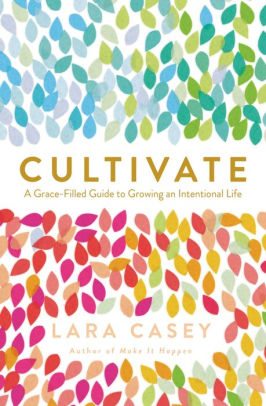It’s not unusual to hear someone say she wants to be intentional in parenting or evangelism or managing money or maintaining a healthy lifestyle. It sounds good when we say it; the hard part is figuring out how to do it.
In her new book, Cultivate: A Grace-Filled Guide to Growing an Intentional Life, Lara Casey considers what it means to live intentionally and offers practical ideas for doing so. Casey—wife, mother to three, and founder of Southern Weddings Magazine—focuses on the transformative power of the gospel to change not only our status before God, but to redeem every aspect of our day-to-day lives.

Cultivate: A Grace-filled Guide to Growing an Intentional Life
Lara Casey
Cultivate: A Grace-filled Guide to Growing an Intentional Life
Lara Casey
Throughout the book, Casey draws lessons for her spiritual life from her experience growing a garden. Though she considers herself an unlikely gardener, as she has cultivated the soil of her garden the Lord has given her a harvest of wisdom about how to cultivate an intentional life. Casey argues that “cultivating an intentional life is about serving the Lord for his purposes and growing what matters with him” (10).
The book is filled with practical ideas for how to cultivate an intentional life. Here are nine of my favorites.
1. Be Reflective
Reflection is something Casey demonstrates more than she explains. The very essence of the book is Casey reflecting on what God has taught her through her garden and then considering how she and others can apply those lessons. This practice is basic but easy to skip. When we simply file away our daily experiences without considering how the Lord might use them in our lives, we fail to be intentional.
2. Replace Lies with Truth
Each of the book’s 10 chapters is focused on replacing a commonly believed lie with truth. For example, chapter five deals with the lie “I have to know all the details of the path ahead” and replaces it with “Forethought is important, but faith is essential” (99). While these lie-and-truth pairings might’ve been more powerful if the truths were directly taken from Scripture, the principle Casey demonstrates is still helpful. Being intentional involves identifying lies we believe and combating them with God’s truth, just as Jesus did when tempted in the wilderness.
3. Attach Your Feelings to Truth
While our emotions are a good part of how God has made us, Casey reminds us we must be intentional in how we process them. She explains, “Feelings aren’t the enemy, but sometimes they can lead us away from truth” (53). So one way to be intentional is to “take your feelings and attach to each of them a life-giving truth” (53). She gives examples like, “I may feel alone, isolated, and lonely at times, but I know that God never, ever leaves me” (53).
4. Embrace Your Season
Casey explains the importance of seasons for the health and flourishing of her garden, and reminds us that the same is true for our lives. Whatever season we’re in, she encourages us to
open your heart and your hands to what [God] has for you. Your season will not last forever, but it might have something really good for you that you don’t want to miss by fighting the season you’re in, fighting the changes, or fighting what feels imperfect. (52–53)
5. Set Good Goals
Goal-setting is widely recognized as a helpful practice, but to make the best use of it we must be careful to set the right goals. Casey writes, “Good goals are about stewarding well what you’ve been given: your relationships, your money, your possessions, your work, your home, your health, and your time” (76).
6. Take One Step Forward
Rather than feeling paralyzed when a task seems too big or too hard, Casey encourages us to take just one step. Do the next thing. Reflecting on her adoption experience, she writes: “We took the next step and emailed an adoption agency. One step forward at a time, Ari and I filled out mountains of paperwork and prayed through our many fears and feelings of not being equipped for this” (100). Their adoption began with an email and ended with a little girl added to their family.
7. Be the Invitation
With regard to relationships, cultivating an intentional life means being willing to take initiative. As Casey explains, “Don’t wait for community to show up at your door: be the invitation. Ask someone to come over, even if your house is a mess” (197).
8. Be Content with Little-by-Little Progress
Many of us can identify with Casey when she shares that she used to be “addicted to instant gratification, searching for contentment in whatever was easy and fast” (7). To combat this tendency, she encourages us to stop “living for the short term and patching things to just get by” and instead take a long-term view (6). Being intentional isn’t so much about quick results as it is “little-by-little progress, and trusting God to make [things] grow in his timing” (7).
9. Preserve and Remember
Just as Casey and her daughter make jams to preserve their fruit harvest for future enjoyment, she challenges us to preserve remembrances of God’s faithfulness for seasons ahead. She suggests things like create a photo wall, keep a blessing jar, write notes in the margins of a family Bible, or journal.
While Casey gives us lots of things we can do to live intentionally, she also reminds us that what ultimately defines our lives is not what we do, but what Jesus Christ has done for us. She writes, “We don’t have to fix our lives; we just have to fix our eyes on him. And not because we have to, but because his grace makes us want to. He will help us” (66).

































